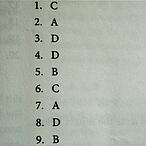 As a GMAT tutor, I have seen coutnless overeager GMAT studiers often make the mistake of taking test after test without making the most of them.
As a GMAT tutor, I have seen coutnless overeager GMAT studiers often make the mistake of taking test after test without making the most of them.
Professional tests and modules are few and far between, and cost considerable money. Consuming this material quickly is neither the most cost-efficient nor smart method of preparing for the test, given the way it is prepared.The GMAT draws on a relatively limited lexicon of theorems and rules that are typically almost entirely covered after three or four practice exams. Mastering the content is only one factor in scoring successfully on the exam. Moving quickly through practice tests ignores some of the more rudimentary, yet critical aspects on being prepared on test day.
It may sound very strange, but students must understand that they need not prepare only for the mental challenges of the GMAT, but the physical ones as well during their standardized test preparation.
First and most obviously, the GMAT lasts roughly four hours. Test takers often nibble at modules and even full tests in bits and pieces, stopping the clock to go to the bathroom and breaking up their work to eat lunch or take a break. These practices leave test takers woefully prepared for the realities of the big day. Physically preparing for the grueling time commitment of the test is essential to be prepared for it.
Minor aspects of the in-test experience are equally overlooked.
1) Students almost always make the mistake of using pen and paper when preparing. The feel and spacing of a dry erase board are entirely different, and using a felt-point marker is often jarring to GMAT students not expecting it.
2) Similarly, the ability to have an on-screen timer tends to distract students who have not visually prepared for this component.
3) Taking the time to practice with a watch and pay attention to progress vis-à-vis time management is another crucial component of preparation.
4) Finally, students must pay detailed attention to the answers to their practice exams, and not just for the sake of learning the content. As any good GMAT test taker knows, the exam offers questions based on performance. The better you do, the harder the questions become. Students can track the way this formula scales up questions by paying attention to the answers and patterns on the practice tests. This practice is critical because test takers often psyche themselves out based on the difficulty – or easiness – of questions at any given part of the test. Students begin to doubt their prior performance, and even consider nullifying the results of the test without seeing their score.
I myself had an algebra problem as my second-to-last question on the exam that I felt to be far too easy for that late stage. Having listed my top five schools for the GMAC to send my scores, I strongly considered cancelling my score before seeing it to salvage my business school admissions chances. Opting to know how I did, I begrudgingly accepted it. Moments later, I was stunned to see my score: 780.

Comments